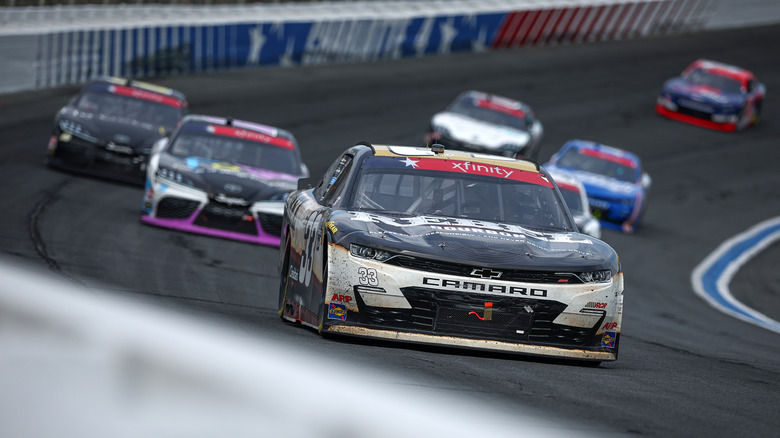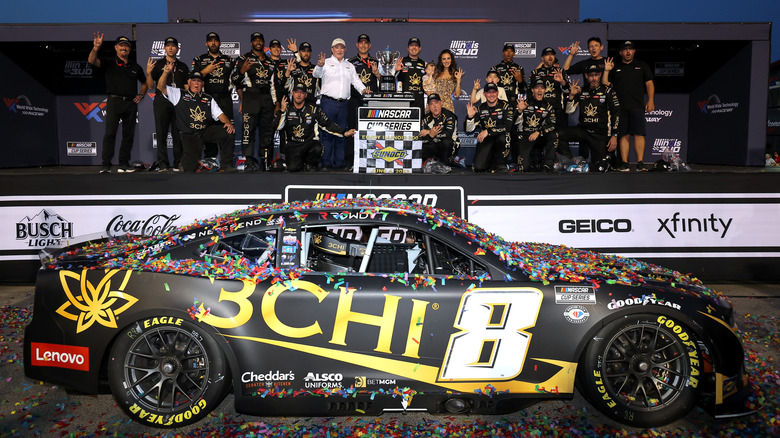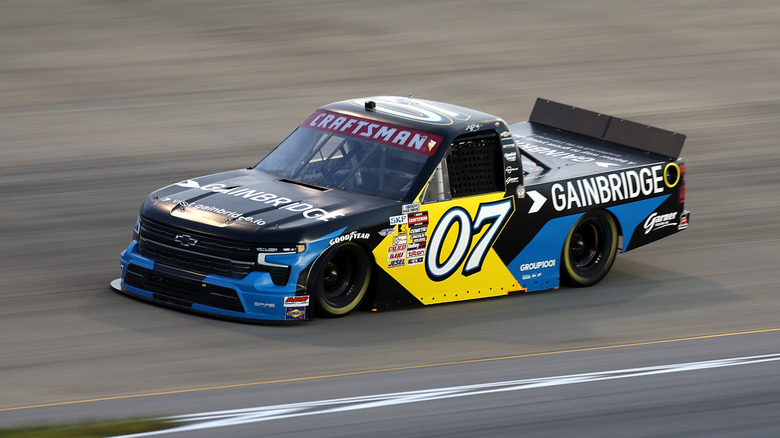NASCAR Is Finally Reversing Its 'Kyle Busch Rule' – Here's What That Means For Racers
Any time there's a rule named after you in a major sport, chances are you've done some pretty notable things. And that's indeed what veteran NASCAR star Kyle Busch has done over his career while competing in — and dominating NASCAR's second and third-tier national series, the O'Reilly Auto Parts Series (formerly known as the Xfinity Series) and the Craftsman Truck Series.
In NASCAR, it's the Cup Series that's the premier level, and Kyle has no shortage of accolades racing there. Kyle Busch helped put Toyota on the map in NASCAR, with a Cup career that includes two series championships and 63 race wins. But for a lot of racers, that's not enough. Sure, one of the main purposes of the lower-level series is to funnel younger drivers into Cup competition, but established Cup drivers have long been able to compete in these races alongside the young guns.
In the late 2000s and into the 2010s, Kyle racked up wins in these races at record levels. He eventually won so often in the lower levels that fans got turned off, and NASCAR implemented the so-called Kyle Busch Rule beginning in 2017. This rule had become increasingly stringent on the number of Xfinity and Truck Series races full-time Cup drivers were able to run. But now, ahead of the 2026 season, NASCAR has loosened up the rule, doubling the number of opportunities for Cup drivers in the O'Reilly Series, and shaking things up for Cup veterans and developing drivers alike.
Where did the Kyle Busch Rule come from?
It wasn't just that Kyle Busch won these lower-level races, it was the sheer number of races he competed in. The results speak for themselves. Kyle has 102 career Xfinity wins along with 67 truck series wins –making him the all-time wins leader in both series. Together with his Cup success, that makes him the all-time winningest driver across NASCAR's national series. In its most recent form, the Kyle Busch rule limited drivers with three or more years of Cup-level experience to just five Xfinity/O'Reilly's or Truck Series races per season. But beginning in 2026, Cup drivers can now to compete in up to 10 O'Reilly's races and eight Truck Series races.
If you're unfamiliar with NASCAR, you might be wondering why top-level Cup Series drivers would have any interest in competing in lower-tier series in the first place. Wouldn't that be like MLB superstar Shohei Ohtani (who also has a rule named after him) wanting to also play in AA or AAA games? Racing is different. Between prize money and sponsor support, there can be a lot of incentive for the top guys to run at lower levels. And a lot of drivers simply love to race whenever given the chance. Running in the lower series can also help Cup drivers get valuable seat time on new or unfamiliar tracks, like the new street course on an active military base in San Diego that will be run next season.
More chances for star power?
While it could be viewed as unfair for the big guys to come down and dominate the lower ranks, most young drivers welcome the chance to compete against the stars. This helps them hone their craft against drivers they hope to someday face in Cup racing. As for the rule itself, it's more a scaling back than a complete reversal. Rather than returning to an era where Cup Series drivers could dominate the lower series every week, the new rule will simply allow more opportunities for them to compete in select O'Reilly and Craftsman Truck Series events. It remains to be seen how many Cup regulars will take advantage of these additional opportunities next year, but Ross Chastain is one driver already eyeing an expanded schedule for 2026 in the wake of the rule change.
Recently-crowned 2025 NASCAR Cup Series champion Kyle Larson is another star who sometimes runs in these lower-tier series, which often share race weekends with the Cup Series. At Homestead-Miami Speedway, in the spring of 2025 Larson ran all three of the series over one weekend, winning the truck race and the Cup Series race, but narrowly missing the sweep after losing the Xfinity Series following an overtime restart. With NASCAR searching for more ways to build star power in the face of declining ratings, perhaps this rule change will allow more opportunities for memorable NASCAR moments where star drivers can show their dominance across the sport's different series.


